A Comprehensive Study of Dynamic and Heat Transfer Characteristics of Droplet Impact on Micro-Scale Rectangular Grooved Surface
Abstract
:1. Introduction
2. Numerical Model and Experimental Study
2.1. Numerical Method
2.2. Physical Model
2.3. Experimental Study and Validation of Numerical Model
3. Numerical Results and Discussion
3.1. Dynamic Characteristics of Droplet
3.2. Heat Transfer Characteristics of Grooved Surface
4. Conclusions
- When the droplet impacts on grooved surface, the vertical spreading diameter of droplet is less than the parallel spreading diameter. The period of droplet spreading in vertical and parallel direction is not synchronous owing to the existence of microgrooves. In the later stage of the impact process, the anisotropy of droplet morphology becomes more significant.
- The dynamic characteristics of droplet is the coupling effect of contact angle and groove width. With the increase of contact angle, the maximum vertical spreading factor and maximum parallel spreading factor all decrease, and the anisotropy of droplet morphology tends to reduce. The transition of wettability state tends to occur with the increase of groove width. Besides, the time needed to arrive at the maximum spreading factor becomes less with increasing contact angle.
- With the increase of impact velocity, the maximum vertical spreading factor and maximum parallel spreading factor all increase, and the anisotropy coefficient of droplet increases. Moreover, the maximum heat transfer rate of grooved surface increases with increasing impact velocity.
- The effect of surface temperature on the maximum spreading factor of droplet is relatively small. With the increase of surface temperature, the heat transfer rate of grooved surface increases. Furthermore, it is observed that the time needed to arrive at the maximum heat transfer rate is not synchronous with different surface temperatures.
- The heat transfer characteristics of grooved surface is the coupling effect of contact angle and groove width. The maximum heat transfer rate of grooved surface decreases with increasing contact angle. Furthermore, all these micro-scale grooved structures with different groove widths cannot enhance the heat transfer with the eigen contact angle of 135°.
Author Contributions
Acknowledgments
Conflicts of Interest
Nomenclature
| U | Velocity vector |
| T | Temperature |
| P | Pressure |
| t | Time |
| λ | Thermal conductivity |
| μ | Viscosity |
| ρ | Density |
| Cp | Specific heat capacity |
| σ | Surface tension coefficient |
| κ | Boundary curvature |
| Φ | Symbol distance function |
| Sm | Interphase mass transfer source |
| r | Mass transfer time coefficient |
| k | Volume fraction |
| D | Groove depth |
| S | Groove space |
| W | Groove width |
| L | Latent heat of evaporation |
| CA | Contact angle |
| We | Weber number |
| d | Diameter |
| β | Spreading factor |
| ε | Anisotropy coefficient |
| N | Total number of computational meshes |
| V0 | Initial droplet volume |
| H | Dripping height |
| Subscript | |
| 0 | Initial |
| Flat | Droplet impact on flat surface |
| vertical | Droplet impact on grooved surface, vertical direction |
| parallel | Droplet impact on grooved surface, parallel direction |
| max | Maximum value |
References
- Strotos, G.; Nikolopoulos, N.; Nikas, K.S.; Moustris, K. Cooling effectiveness of droplets at low weber numbers: effect of temperature. Int. J. Therm. Sci. 2013, 72, 60–72. [Google Scholar] [CrossRef]
- Liang, G.; Mudawar, I. Review of drop impact on heated walls. Int. J. Heat Mass Transf. 2017, 106, 103–126. [Google Scholar] [CrossRef]
- Hsieh, S.S.; Luo, S.Y. Droplet impact dynamics and transient heat transfer of a micro spray system for power electronics devices. Int. J. Heat Mass Transf. 2016, 92, 190–205. [Google Scholar] [CrossRef]
- Xu, W.W.; Luo, J.F.; Qin, J.; Zhang, Y.M. Maximum deformation ratio of droplets of water-based paint impact on a flat surface. Coatings 2017, 7, 81. [Google Scholar] [CrossRef]
- Wu, J.; Li, Y.D. Dynamic performance of a static or throwing droplet impact onto a solid substrate with different properties. Physica A 2016, 446, 158–170. [Google Scholar] [CrossRef]
- Kim, H.Y.; Chun, J.H. The recoiling of liquid droplets upon collision with solid surfaces. Phys. Fluids 2001, 13, 643–659. [Google Scholar] [CrossRef]
- Jin, Z.; Sui, D.; Yang, Z. The impact, freezing, and melting processes of a water droplet on an inclined cold surface. Int. J. Heat Mass Transf. 2015, 90, 439–453. [Google Scholar] [CrossRef]
- Moon, J.H.; Kim, D.Y.; Lee, S.H. Spreading and receding characteristics of a non-newtonian droplet impinging on a heated surface. Exp. Therm. Fluid Sci. 2014, 57, 94–101. [Google Scholar] [CrossRef]
- Min, C.; Connolly, E.; Chen, T.; Jozsef, G.; Formenti, S.C. Experimental and theoretical study of the impact of alumina droplets on cold and hot substrates. Plasma Chem. Plasma Process. 2003, 23, 185–221. [Google Scholar]
- Wang, M.J.; Hung, Y.L.; Lin, F.H.; Lin, S.Y. Dynamic behaviors of droplet impact and spreading: A universal relationship study of dimensionless wetting diameter and droplet height. Exp. Therm. Fluid Sci. 2009, 33, 1112–1118. [Google Scholar] [CrossRef]
- Wang, M.J.; Lin, F.H.; Ong, J.Y.; Lin, S.Y. Dynamic behaviors of droplet impact and spreading—Water on glass and paraffin. Colloid Surf. A 2009, 339, 224–231. [Google Scholar] [CrossRef]
- Sang, J.L.; Huh, H.K.; Kwon, D.H. Energy dissipation of graphene colloidal suspension droplets impacting on solid substrates. RSC Adv. 2014, 4, 7216–7224. [Google Scholar]
- Khojasteh, D.; Kazerooni, N.M.; Salarian, S.; Kamali, R. Droplet impact on superhydrophobic surfaces: A review of recent developments. J. Ind. Eng. Chem. 2016, 42, 1–14. [Google Scholar] [CrossRef]
- Malla, L.K.; Patil, N.D.; Bhardwaj, R.; Neild, A. Droplet bouncing and breakup during impact on a microgrooved surface. Langmuir 2017, 33, 9620–9631. [Google Scholar] [CrossRef] [PubMed]
- Lee, J.B.; Lee, S.H. Dynamic wetting and spreading characteristics of a liquid droplet impinging on hydrophobic textured surfaces. Langmuir 2011, 27, 6565–6573. [Google Scholar] [CrossRef] [PubMed]
- Vaikuntanathan, V.; Sivakumar, D. Maximum spreading of liquid drops impacting on groove-textured surfaces: Effect of surface texture. Langmuir 2016, 32, 2399–2409. [Google Scholar] [CrossRef] [PubMed]
- Kannan, R.; Sivakumar, D. Drop impact process on a hydrophobic grooved surface. Colloid Surf. A 2008, 317, 694–704. [Google Scholar] [CrossRef]
- Kannan, R.; Sivakumar, D. Impact of liquid drops on a rough surface comprising microgrooves. Exp. Fluids 2008, 44, 927–938. [Google Scholar] [CrossRef]
- Song, D.; Song, B.; Hu, H.; Du, X.; Ma, Z. Contact angle and impinging process of droplets on partially grooved hydrophobic surfaces. Appl. Therm. Eng. 2015, 85, 356–364. [Google Scholar] [CrossRef]
- Patil, N.D.; Bhardwaj, R.; Sharma, A. Droplet impact dynamics on micropillared hydrophobic surfaces. Exp. Therm. Fluid Sci. 2016, 74, 195–206. [Google Scholar] [CrossRef]
- Khan, M.S.; Kannangara, D.; Garnier, G.; Wei, S. Effect of liquid droplet impact velocity on liquid wicking kinetics in surface v-grooves. Chem. Eng. Sci. 2011, 66, 6120–6127. [Google Scholar] [CrossRef]
- Hao, P.F.; Lv, C.J.; Niu, F.L.; Yu, Y. Water droplet impact on superhydrophobic surfaces with microstructures and hierarchical roughness. Sci. China Phys. Mech. 2014, 57, 1376–1381. [Google Scholar] [CrossRef]
- Hu, H.B.; Huang, S.H.; Chen, L.B. Droplet impact on regular micro-grooved surfaces. Chin. Phys. B 2013, 22, 084702. [Google Scholar] [CrossRef]
- Moon, J.H.; Cho, M.; Lee, S.H. Dynamic wetting and heat transfer characteristics of a liquid droplet impinging on heated textured surfaces. Int. J. Heat Mass Transf. 2016, 97, 308–317. [Google Scholar] [CrossRef]
- Parizi, H.B.; Rosenzweig, L.; Mostaghimi, J.; Chandra, S.; Coyle, T.; Salimi, H.; Pershin, L.; McDonald, A.; Moreauet, C. Numerical simulation of droplet impact on patterned surfaces. J. Therm. Spray Technol. 2007, 16, 713–721. [Google Scholar] [CrossRef]
- Wang, L.; Zhang, R.; Zhang, X.; Hao, P. Numerical simulation of droplet impact on textured surfaces in a hybrid state. Microfluid. Nanofluid. 2017, 21, 61. [Google Scholar] [CrossRef]
- Lee, W.; Son, G. Numerical study of droplet impact and filling in a microgroove. Prog. Comput. Fluid Dyn. 2011, 11, 175–183. [Google Scholar] [CrossRef]
- Sussman, M.; Puckett, E.G. A coupled level set and volume-of-fluid method for computing 3d and axisymmetric incompressible two-phase flows. J. Comput. Phys. 2000, 162, 301–337. [Google Scholar] [CrossRef]
- Hong, W.; Wang, Y. A coupled level set and volume-of-fluid simulation for heat transfer of the double droplet impact on a spherical liquid film. Numer. Heat Transf. B Fundam. 2017, 71, 359–371. [Google Scholar] [CrossRef]
- Gihun, S.; Nahmkeon, H. A coupled level set and volume-of-fluid method for the buoyancy-driven motion of fluid particles. Numer. Heat Transf. B Fundam. 2002, 42, 523–542. [Google Scholar]
- Sun, D.L.; Tao, W.Q. A coupled volume-of-fluid and level set (VOSET) method for computing incompressible two-phase flows. Int. J. Heat Mass Transf. 2010, 53, 645–655. [Google Scholar] [CrossRef]
- Brackbill, J.U.; Kothe, D.B.; Zemach, C. A continuum method for modeling surface tension. J. Comput. Phys. 1992, 100, 335–354. [Google Scholar] [CrossRef]
- Wen, H.L. A Pressure Iteration Scheme for Two-Phase Flow Modeling, Computational Methods for Two-Phase Flow and Particle Transport; Hemisphere: Washington, DC, USA, 1980; pp. 61–82. [Google Scholar]
- Jiang, F.; Wang, Y.; Xiang, J.; Liu, Z. A comprehensive computational fluid dynamics study of droplet-film impact and heat transfer. Chem. Eng. Technol. 2015, 38, 1565–1573. [Google Scholar] [CrossRef]
- Teodori, E.; Pontes, P.; Moita, A.; Georgoulas, A.; Marengo, M.; Moreira, A. Sensible heat transfer during droplet cooling: Experimental and numerical analysis. Energies 2017, 10, 790. [Google Scholar] [CrossRef]
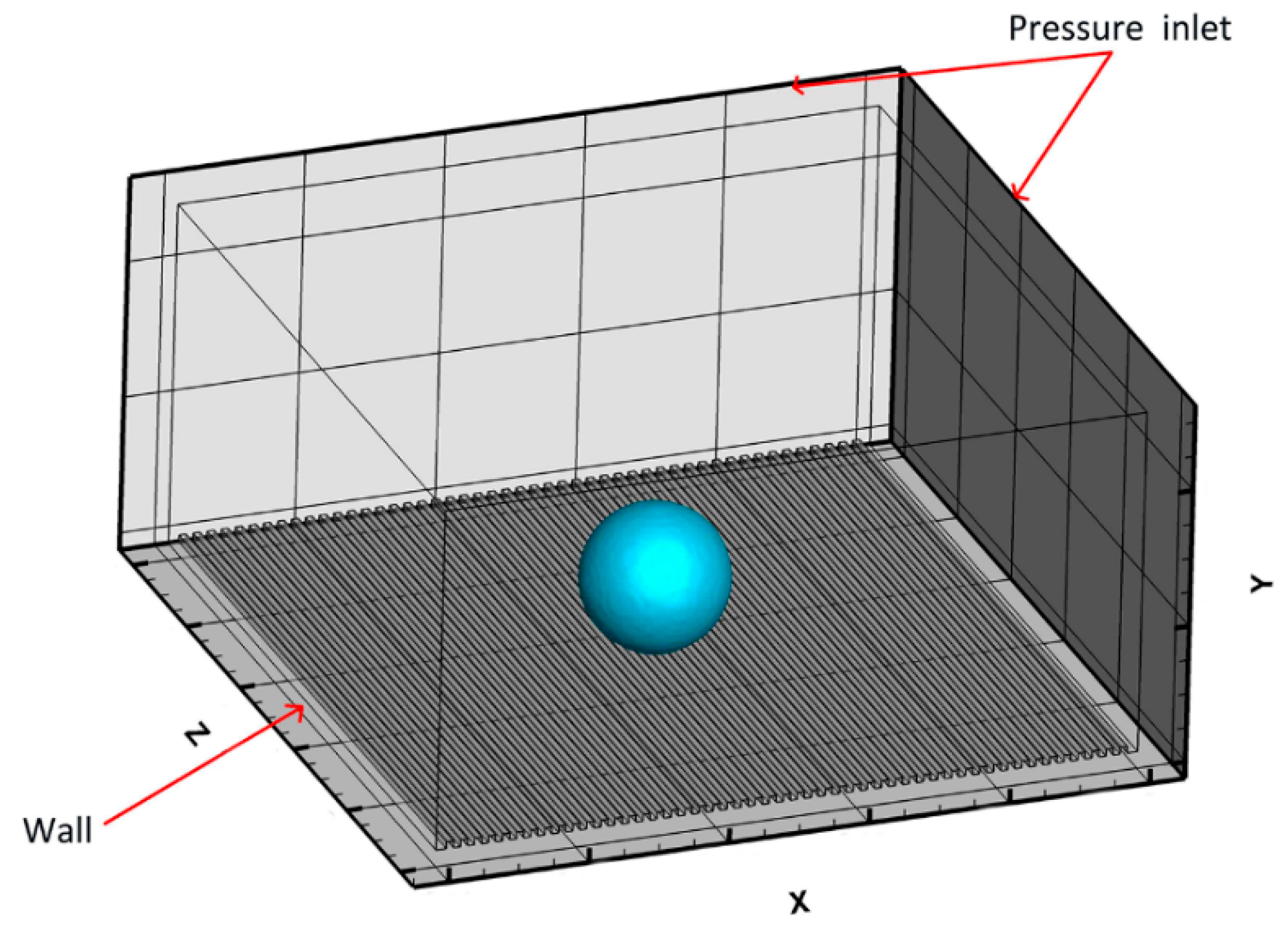
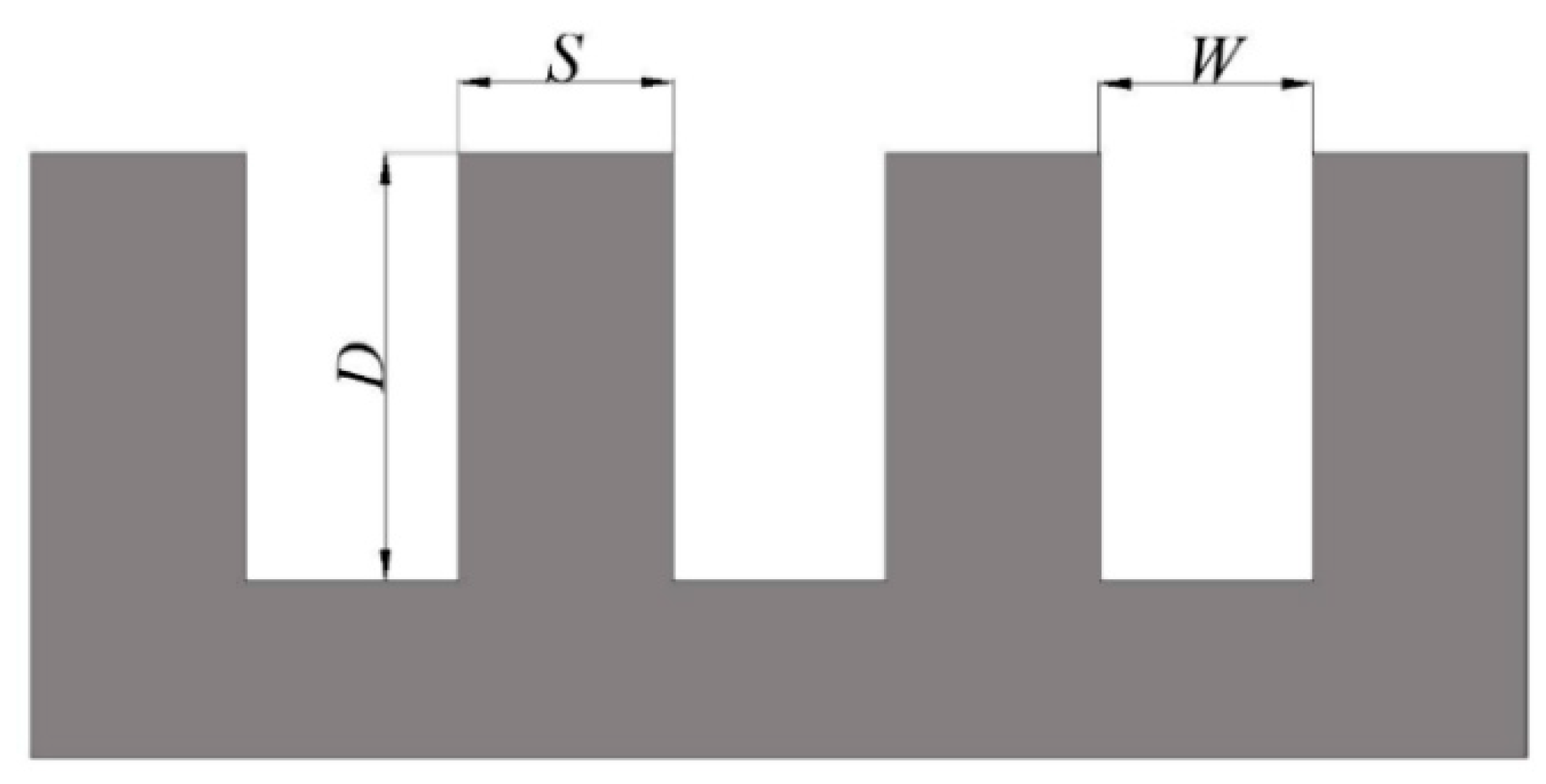
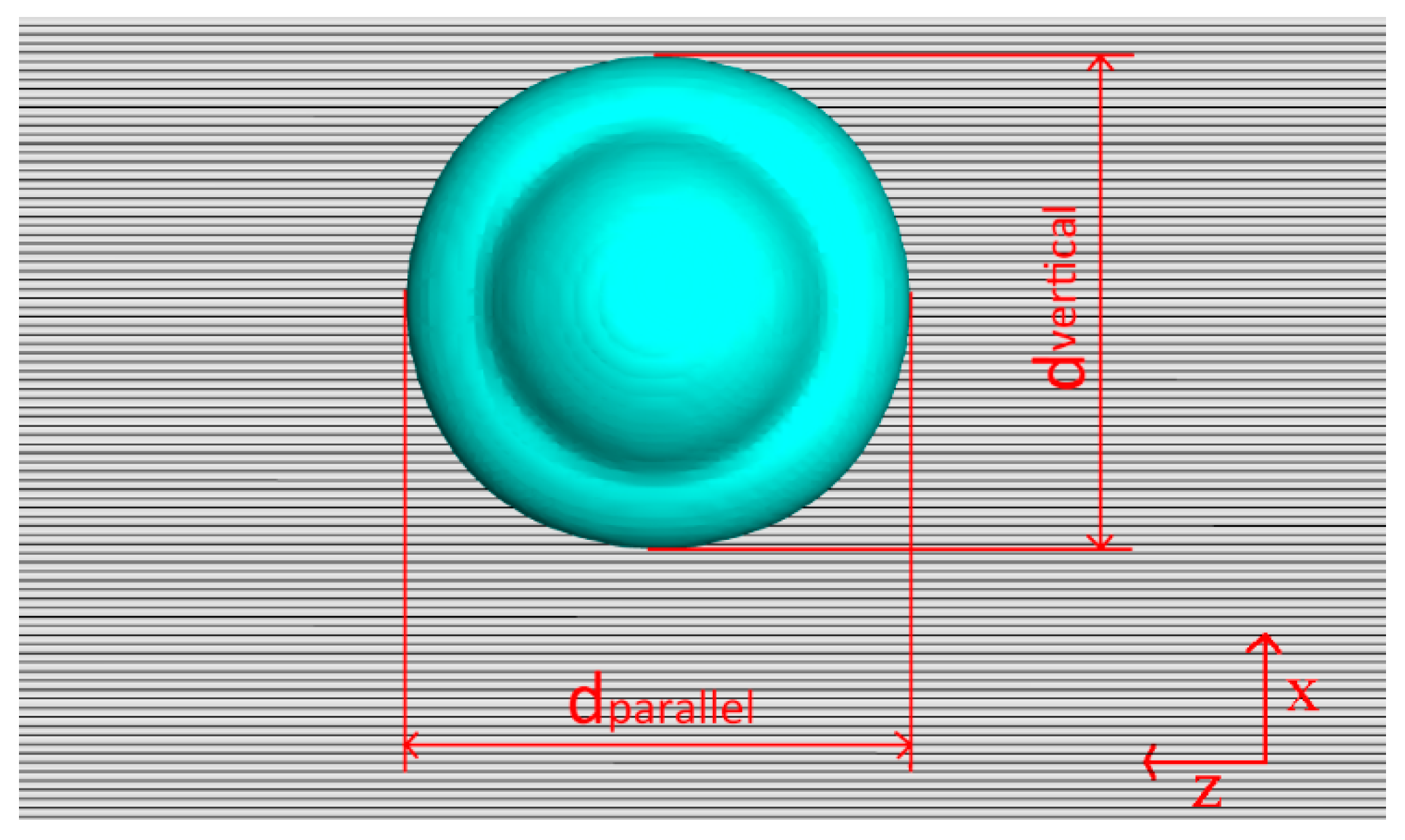

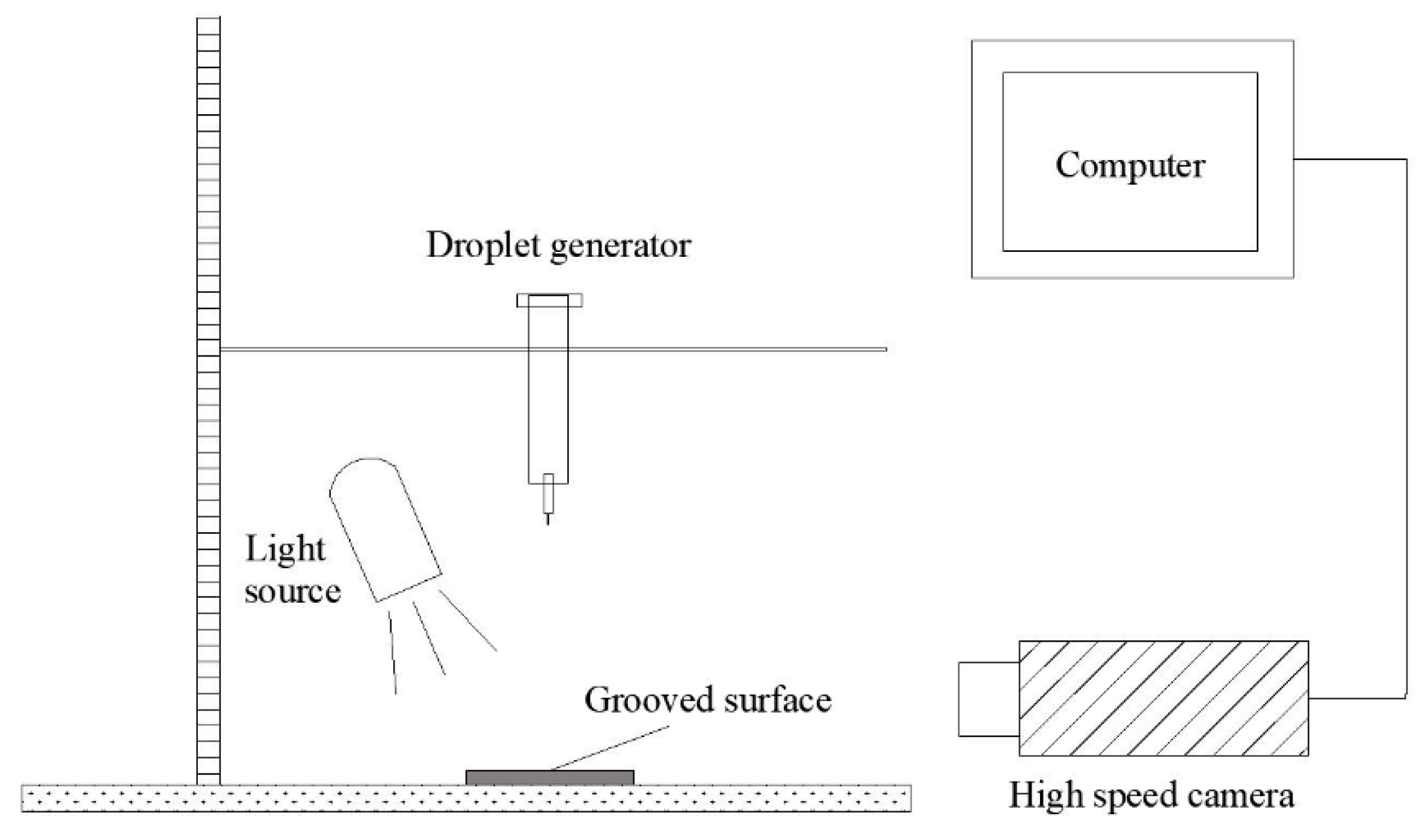

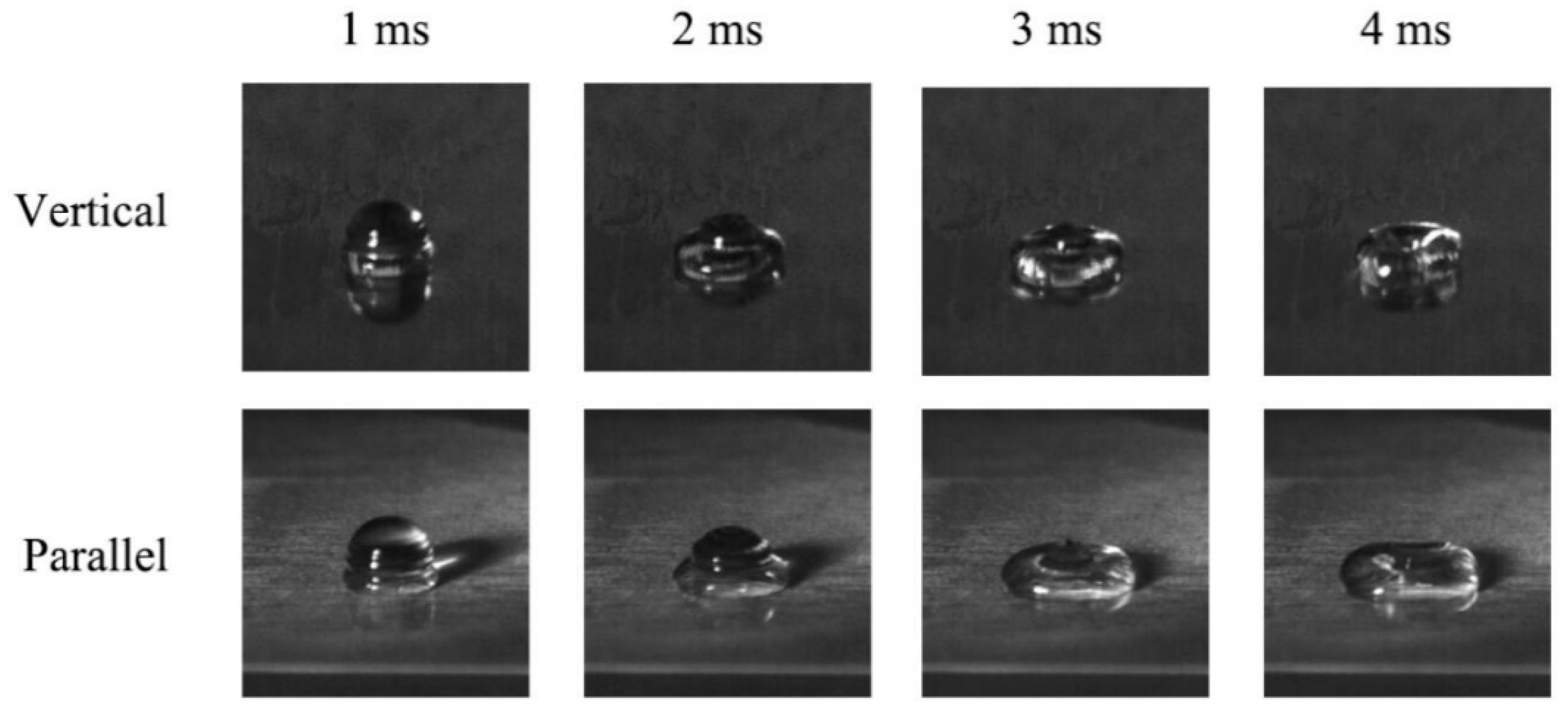

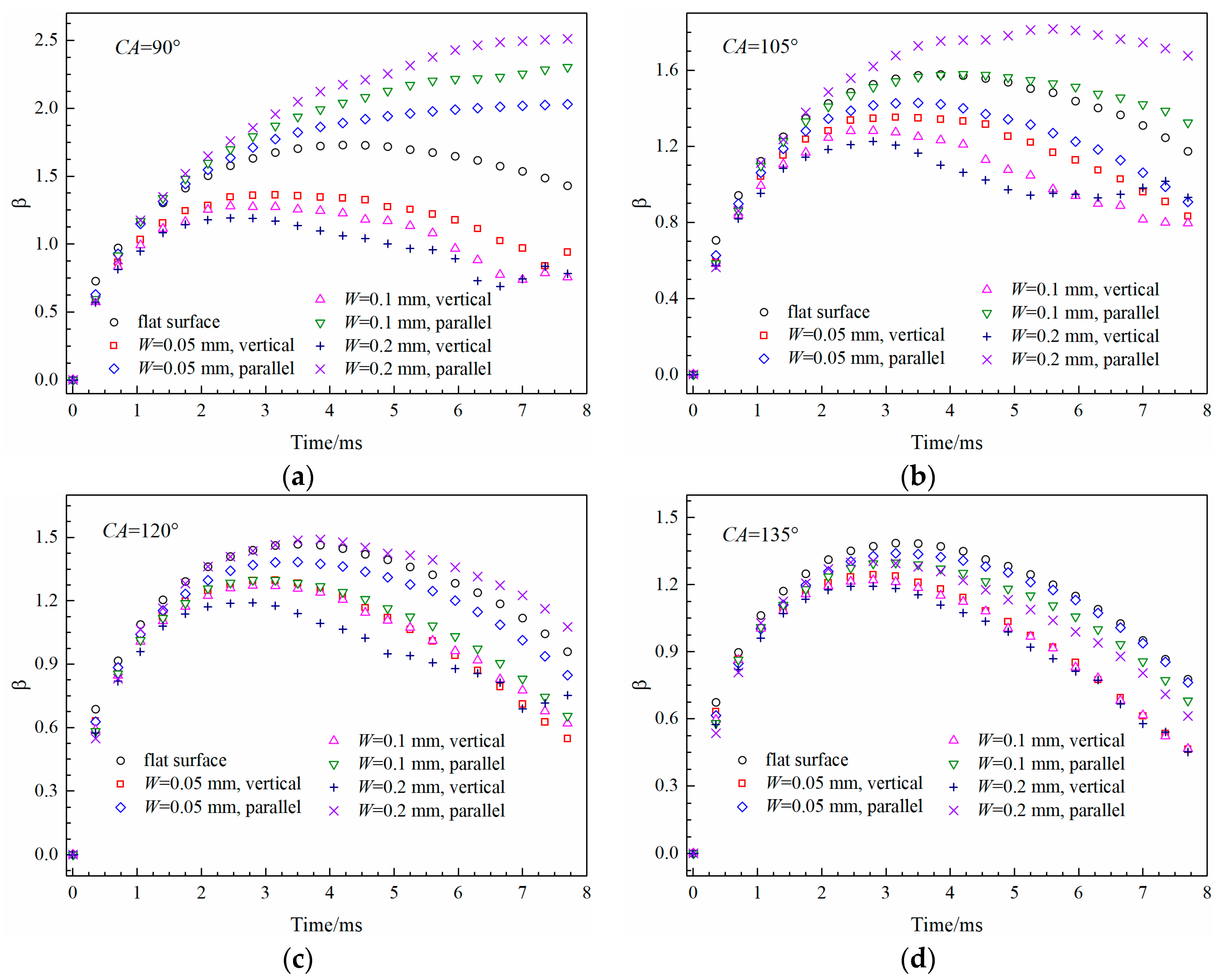

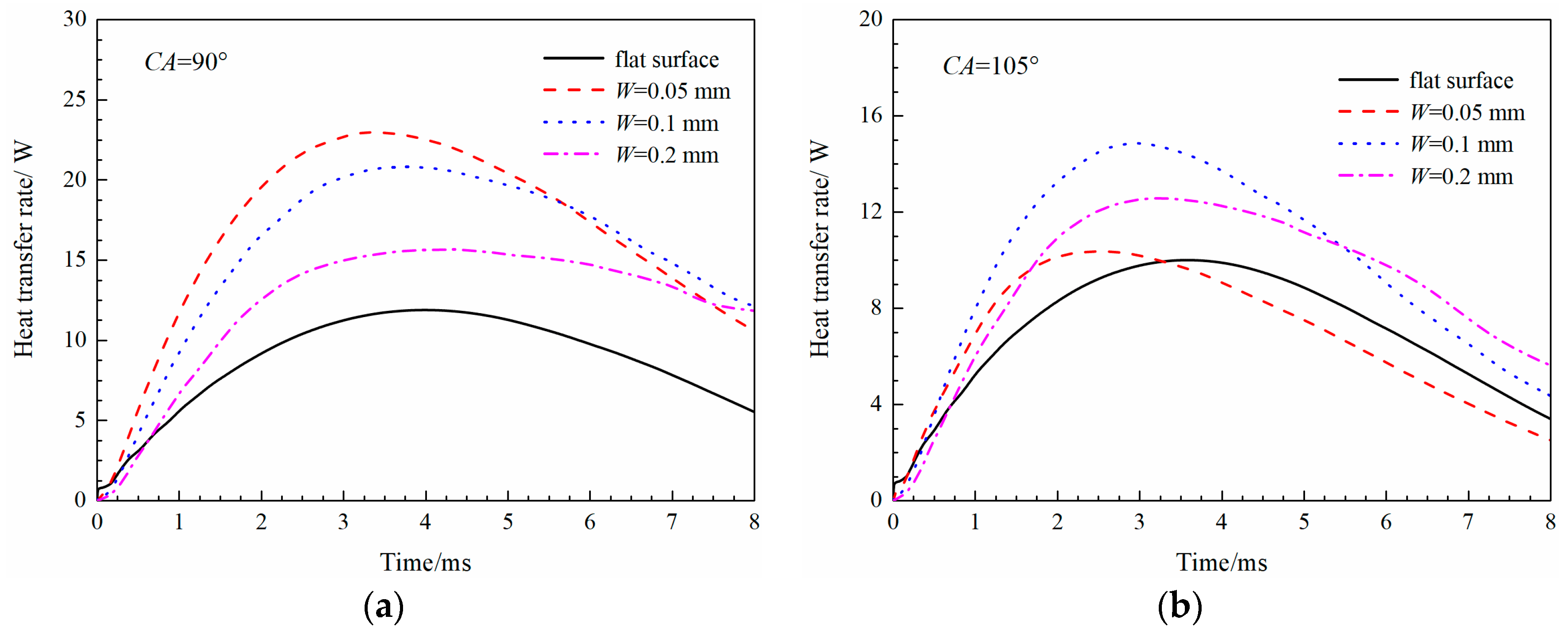
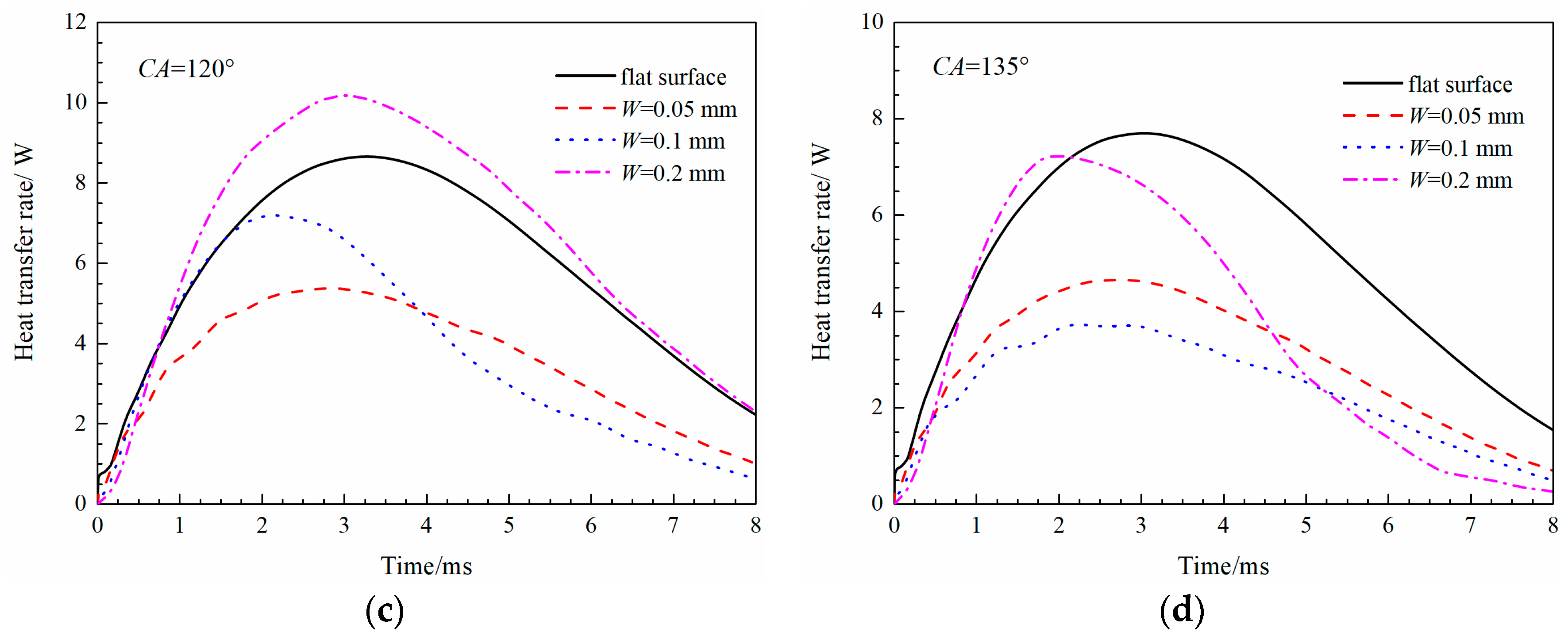




| Physical Parameters | Values |
|---|---|
| d0 (mm) | 2 |
| T (K) | 293.15 |
| ρ (kg/m3) | 998.2 |
| μ (Pa·s) | 0.001 |
| σ (N/m) | 0.073 |
| Cp (kJ/(kg·K)) | 4.187 |
| λ (W/(m·K)) | 0.599 |
| L (kJ/kg) | 2257 |
| Measurement Quantity | Measuring Equipment | Uncertainty |
|---|---|---|
| Temperature | K-type thermocouple, A/D converter | = 0.757% |
| Droplet volume | Droplet generator | = 0.898% |
| Dripping height | Vernier caliper | = 0.2% |
| Velocity | ε (W = 0.05 mm) | ε (W = 0.1 mm) | ε (W = 0.2 mm) |
|---|---|---|---|
| 0.3 m/s | 1.0491 | 1.2159 | 1.4551 |
| 0.4 m/s | 1.0554 | 1.2288 | 1.4748 |
| 0.5 m/s | 1.0632 | 1.2430 | 1.5138 |
| Temperature | βvertical, max | βparallel, max | ε |
|---|---|---|---|
| 323.15 K | 1.3398 | 1.4082 | 1.0511 |
| 333.15 K | 1.3442 | 1.4142 | 1.0521 |
| 343.15 K | 1.3506 | 1.4225 | 1.0532 |
| 353.15 K | 1.3539 | 1.4289 | 1.0554 |
© 2018 by the authors. Licensee MDPI, Basel, Switzerland. This article is an open access article distributed under the terms and conditions of the Creative Commons Attribution (CC BY) license (http://creativecommons.org/licenses/by/4.0/).
Share and Cite
Yan, Z.; Li, Y. A Comprehensive Study of Dynamic and Heat Transfer Characteristics of Droplet Impact on Micro-Scale Rectangular Grooved Surface. Energies 2018, 11, 1390. https://doi.org/10.3390/en11061390
Yan Z, Li Y. A Comprehensive Study of Dynamic and Heat Transfer Characteristics of Droplet Impact on Micro-Scale Rectangular Grooved Surface. Energies. 2018; 11(6):1390. https://doi.org/10.3390/en11061390
Chicago/Turabian StyleYan, Zhe, and Yan Li. 2018. "A Comprehensive Study of Dynamic and Heat Transfer Characteristics of Droplet Impact on Micro-Scale Rectangular Grooved Surface" Energies 11, no. 6: 1390. https://doi.org/10.3390/en11061390





